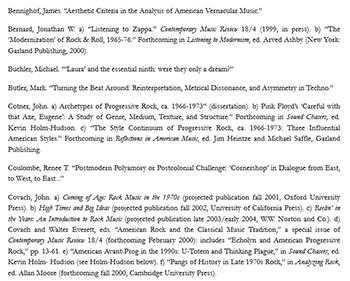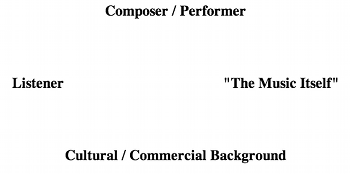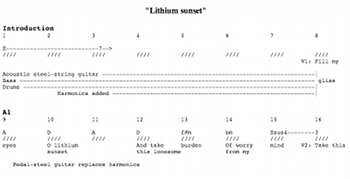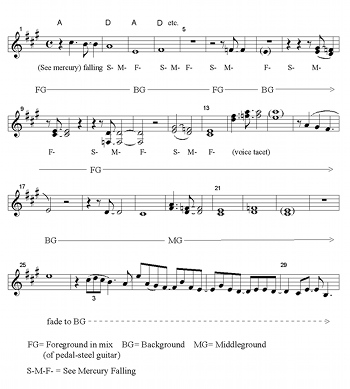Revenge of the Boomers: Notes on the Analysis of Rock Music
Peter M. Kaminsky
KEYWORDS: rock, popular music, analysis, Sting
ABSTRACT: The increasing interest by music theorists in rock/pop analysis represents a reconciliation of their formative involvement with both classical and popular musics. In striving toward an appropriate analytical methodology, theorists must negotiate between conflicting claims of salience for both musical and extra-musical factors. After commenting on three historically important and representative theorists (Tagg, Middleton, and Everett), the paper presents an analysis of a song by Sting, relating structural features of the music to his appropriation of country music and interpreting "stylistic dissonances" between structure and style as significant to the textual and musical narrative.
Copyright © 2000 Society for Music Theory
[1] I shall begin this talk with two stories, both true. Going through my recent Email, I received messages from two prominent scholars—one in music theory, the other in ethnomusicology—requesting a copy of this paper after having seen the title listed in the program for the New England Conference of Music Theorists. No one had ever asked me for a copy of a paper that I had not even finished yet. This is a reliable sign that the theory and analysis of rock music is, as the song goes, “hot hot hot.” Back in November following my return from the national SMT meeting in Atlanta, I was meeting one of my freshman theory students, a guitarist, in office hours. He asked me how the conference was, and I told him that one of the most interesting papers I heard was an hour and a half long analysis of “Enter Sandman” by Metallica, where the author transcribed not only the lead guitar part but also the progression of the wah-wah pedal, adapting Slawson’s theory of sound color to its spectrum of timbres. My student looked at me, rolled his eyes, and said, “You’ve got to be kidding.” Taken together, my two stories suggest something of the odd nature of scholarship on rock and popular music: viewed by some with disbelief that such music is worthy of analytical investigation, and viewed by others as the next frontier, the ocean floor waiting to be mapped.
[2] In surveying the current literature, one reason for the exponential growth in this area is the attempt by a younger
generation of theorists to deal with a kind of collective schizophrenia, born from deep involvement with both classical and
popular musics. In a recent essay on compositional design in the early music of the
progressive British rock band Genesis, Mark Spicer expresses a feeling that many if not most rock music
scholars share: “Writing a ‘serious’ essay about Genesis for this book has been especially significant for me. As I was growing up
in the late 1970s and 1980s—and playing in as many rock and pop bands as I did orchestras—this group was one of the main reasons
why I came to love music and to love thinking about music
[3] My talk will be in two parts. Part I will briefly survey some issues of methodology in rock/pop analysis. Part II will present my analysis of a song written and performed by Sting, in which I shall position the analysis within the field in the terms proposed in Part I.
Table 1. Selected Bibliography of Ongoing Projects in Rock/Pop Analysis
(click to enlarge and see the rest)
Figure 1. Poles of orientation
(click to enlarge)
[4] To assess the current state of research, I recently submitted a questionnaire to both the SMT list and the pop music analysis list, asking scholars for a description of their ongoing projects which have not yet been published. I received responses from twenty-eight theorists (many with multiple projects) from the United States, Canada, and England. Table 1 is a bibliography of those projects which you may peruse at your leisure. Given the tremendous variety of subjects and perspectives, I have conceived an admittedly crude schema by which these works—and by extension work within the broader field of rock/pop analysis—may be categorized. Figure 1 shows what I have termed the four “poles of orientation”: 1) the composer/performer, 2) the listener, 3) cultural/commercial issues, and 4) the “music itself.” For the most part, rock/pop music analysts take a position that gravitates toward one of these four poles, sometimes toward two, and more rarely may be placed in the center as part of a more thoroughly interdisciplinary perspective. Naturally these poles exist for the study of classical music as well. By bringing them to the forefront of popular music scholarship, however, one is forced to consider more closely some fundamental distinctions between repertories. For example, how is the role of the listener and the listener’s musical experience different for rock/pop than for classical music? In what ways may the notion of “authorship” be different for popular music? How do commercial issues influence music production and dissemination? What musical factors take on greater or lesser salience in rock/pop music as opposed to classical?
[5] Indeed, it is this last question—the identity of salient musical factors in popular music and the consequences for an appropriate analytical methodology—that lies at the polemical heart of an ongoing scholarly debate. There is no need to rehearse this debate here. Instead I shall speak briefly about three prominent scholars whose work has been important in shaping the field of rock/pop analysis, and whose approaches are broadly representative.
[6] Historically, Philip Tagg’s 1982 article, “Analysing Popular Music: Theory, Method and Practice,” represents one of the earliest serious attempts at a musicology of popular music. In it he enunciates several propositions which have become axiomatic for a number of subsequent analysts:
- “Studying popular music is an interdisciplinary matter.”
“. . . popular music cannot be analysed using only the traditional tools of musicology.”- “[Musical] hermeneutics [rigorously and carefully applied]
. . . in combination with other musicological subdisciplines, especially the sociology and semiology of music, make an important contribution to the analysis of popular music. In short: a rejection of hermeneutics will result in sterile formalism while its unbridled application can degenerate into unscientific guesswork.”(2)
Significantly, Tagg eschews any music smacking of canonical or masterwork tendencies, instead analyzing in great detail the theme from the TV show Kojak and the Abba song “Fernando.” While not ignoring structural aspects, he folds them into a semiotic approach that emphasizes the conventional codes underlying relevant musical affects; in this sense Tagg attempts a kind of Affektenlehre for popular music. For example, he finds affective correlations between the falling tritone in Abba’s “Fernando” and the same interval in Bach’s St. Matthew Passion, Gluck’s Orfeo et Euridice, and the Righteous Brothers’ “You’ve Lost that Loving Feeling.”
[7] While clearly influenced by Tagg, Richard Middleton attempts to reconcile in more explicit terms the multiplicity of analytical approaches to popular music. In a 1993 article in the journal Popular Music, he proceeds from a fundamental assumption: that popular music differs from classical in its emphasis on rhythm—not only duration and accentuation, but more broadly the patterned movement of musical elements. In striving toward a theory of gesture, Middleton thereby tries to address the importance of physicality and the body in the listener’s response to this music. In turn gesture represents one part of his tripartite model, complemented by what he terms connotation and musical argument (or structure). Perhaps oversimplistically he questions music theory’s overreliance on structural analysis and aligns his position with the broader project in 1980s musicology questioning the means and ends of “formalist” music theory. Even so, he does offer a pragmatic alternative: “What I would suggest is that these three areas—gesture, connotation, argument—operate in different repertories in diverse ratios and interrelationships; and analysis needs to reflect that.”(3)
[8] At the other end of the spectrum stands the work of Walter Everett, including his recently published magnum opus,
The
Beatles as Musicians: “Revolver” through the “Anthology”. In his preface, Everett addresses head-on the criticism of structural
analysis for rock/pop music. “There are those who say that an appreciation of [the Beatles’ music] is not enhanced by any
intellectual understanding. Others say that any example of popular music is to be evaluated not in
relation to its internal musical issues but solely in terms of its social reception, or
that popular music cannot be analyzed to useful ends with tools ‘created’ for the
appreciation of classical music
[9] With respect to an analytical methodology for popular music, the above quotation raises two crucial points. First, by the central position he accords to both structural analysis and source study (in the form of recording sessions and their attendant documentation), Everett knowingly inscribes his project and by extension the music of the Beatles into the canonical mainstream of theory and musicology. Second, the success of such a project depends on the music itself having a degree of structural integrity that can withstand this sort of analytical scrutiny. I would suggest that those musicians about whom the current generation of theorists are devoting “hardcore” analytical studies—the Beatles, Frank Zappa, Led Zeppelin, Pink Floyd, etc.— fulfill this criterion. (To play on Everett’s book, which prospective essay title would make more sense: “The Backstreet Boys as Musicians,” or “The Backstreet Boys as Cultural Icons to the Pre-pubescent”?)
[10] Part II of my paper examines the concluding song, entitled “Lithium Sunset,” from Sting’s 1996 solo album Mercury Falling.(5) My pole of orientation is “the music itself,” and the analysis will explore the traditional domains of form, harmony, instrumentation, and motive, with some consideration of studio technique as appropriate. My analytical point of departure is not uncommon in rock/pop analysis: the appropriation of musical style. Beginning with the 1985 Dream of the Blue Turtles following the breakup of the Police, much of Sting’s solo music employs a specific musical style or genre—e.g., reggae, blues, something I call “film noir,” Irish folk—for aesthetic reasons having to do with the narrative as communicated by the song lyrics. Mercury Falling is no exception and indeed incorporates what for Sting were two new styles: rhythm and blues, and country music. Both are deployed to expressive and ironic effect in representing the cycle’s predominating themes of winter, loss of love, willful illusion, and madness. (The association with Schubert’s Die Winterreise is intentional on my part.)
[11] “Lithium Sunset” appropriates in a radical way not only the musical style of country, but also its penchant for irony—i.e., its use of happy and exuberant music to express broken hearts, betrayals, and other bad things with detachment and the hint of a rueful smile. In Sting’s song, the central image, “lithium sunset,” signals his trope on this theme. As is well known, lithium is the drug of choice in treating severe cases of manic depression. By bringing together lithium and sunset as a compound image, our conventional associations with sunset—the boundary between day and night, beautiful colors, romantic overtones—become distorted through the filter of lithium to suggest the turn of the soul from day to night, the beautiful colors as hallucinations, and romance as the inconsolable loss of love.
[12] In this context, the stylistic choice of country music takes on the character of an assumed identity, the very simplicity of the music mirroring the protagonist’s hope of healing himself in the aftermath of a failed marriage (this part of the story is established in an earlier song). What gives “Lithium Sunset” its resonance is the tension engendered by what I shall term “stylistic dissonance,” which reveals the delusionary character of the protagonist. This dissonance occurs both in the lyrics and the music, manifesting itself in virtual “spikes” of intensity. Lyrically, these spikes constitute poetic images that dissonate against the “normative” irony of country music lyrics noted above: examples include “lithium sunset,” “this heartache of obsidian darkness,” and the desire to “fold my darkness / into your yellow light.” Musically, these spikes of intensity are perceived as gestures that dissonate against the happy and predictable twang typical of country music.
[13] Example 1 provides a basic formal and harmonic outline of
the song. Down the right side of the example, I have shown in greater detail three formal
junctures—the end of the introduction and beginning of the song proper, the vocal and
harmonic climax concluding the bridge, and the end of the reprise into the coda—that help delineate the process of stylistic
dissonance. The introduction features bass, drums, acoustic steel-string guitar, and harmonica sustaining
dominant harmony until bar 8. Here all instruments drop out except the bass, which
executes a falling glissando against which the voice enters with “Fill my eyes.” (The bracketed “x” designates the primary vocal
motive for the song.) The abruptness of the textural change and the bass glissando itself suggest a sense
of weightlessness, like falling through space in a dream, and it serves as a harbinger of
further disorientation. Immediately thereafter the pedal-steel guitar replaces the harmonica and unambiguously establishes
country as the musical style. The song proceeds in relatively predictable fashion until the end of the
bridge (bar 32). Here on the words “Heal my soul,” the harmonic rhythm accelerates and the
progression takes a surprising turn, as
[14] The coda reinforces the sense of delusion by the further incursion of modal mixture, again via the cross-relation between
F and
[15] To conclude, this analysis has employed a conventional methodology, featuring such familiar concepts as modal mixture, cross-relation, phrase extension and hypermetrical reinterpretation, and, more basically, consonance and dissonance itself. I would like to think that my choice of methodology and, more broadly, the nature of my discourse, is not merely the product of training and habit. Rather, I have attempted to evaluate the salience of these features as they relate to a specific interpretative strategy, here based on stylistic appropriation and dissonance. It goes without saying that theories both enable and constrain, giveth and taketh away. I hope that, with this burgeoning of interest in rock and popular music, our striving towards a viable methodology will allow for scholarly and critical acumen as well as the sense of fun, unbridled enthusiasm, ontological complexity, and questioning of authority that inevitably and thankfully come with the territory of popular music.
Peter M. Kaminsky
University of Connecticut
Department of Music
Box U-12
Storrs, CT 06269-1012
KPKambo@aol.com
Peter.Kaminsky@uconn.edu
Footnotes
1. Mark S. Spicer, “Large-Scale Strategy and Compositional Design in the Early Music of Genesis,” in Expression in Pop-Rock Music, ed. Walter Everett (New York: Garland Publishing, 2000), p. 102.
Return to text
2. Philip Tagg, “Analysing Popular Music: Theory, Method and Practice,” Popular Music 2 (1982), pp. 40–43.
Return to text
3. Richard Middleton, “Popular music analysis and
musicology: bridging the gap,” Popular Music 12 (1993), p. 189.
Return to text
4. Walter Everett. The Beatles as Musicians: “Revolver” through the “Anthology” (Oxford: Oxford University Press, 1999), p. x.
Return to text
5. Sting, Mercury Falling, A&M Records, 31454-0483-2, 1996.
Return to text
Copyright Statement
Copyright © 2000 by the Society for Music Theory. All rights reserved.
[1] Copyrights for individual items published in Music Theory Online (MTO) are held by their authors. Items appearing in MTO may be saved and stored in electronic or paper form, and may be shared among individuals for purposes of scholarly research or discussion, but may not be republished in any form, electronic or print, without prior, written permission from the author(s), and advance notification of the editors of MTO.
[2] Any redistributed form of items published in MTO must include the following information in a form appropriate to the medium in which the items are to appear:
This item appeared in Music Theory Online in [VOLUME #, ISSUE #] on [DAY/MONTH/YEAR]. It was authored by [FULL NAME, EMAIL ADDRESS], with whose written permission it is reprinted here.
[3] Libraries may archive issues of MTO in electronic or paper form for public access so long as each issue is stored in its entirety, and no access fee is charged. Exceptions to these requirements must be approved in writing by the editors of MTO, who will act in accordance with the decisions of the Society for Music Theory.
This document and all portions thereof are protected by U.S. and international copyright laws. Material contained herein may be copied and/or distributed for research purposes only.
Prepared by Brent Yorgason and Tahirih Motazedian, Editorial Assistants





